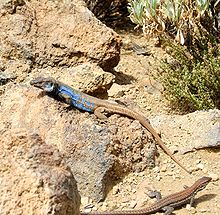
The Canary Islands, also known informally as the Canaries, are a Spanish autonomous community and archipelago in Macaronesia in the Atlantic Ocean. At their closest point to the African mainland, they are 100 kilometres west of Morocco and the Western Sahara. They are the southernmost of the autonomous communities of Spain. The islands have a population of 2.2 million people and are the most populous special territory of the European Union.
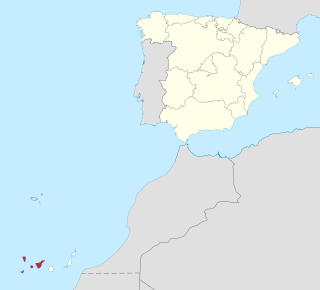
Province of Santa Cruz de Tenerife, also Province of Santa Cruz, is a province of Spain, consisting of the western part of the autonomous community of the Canary Islands. It consists of about half of the Atlantic archipelago: the islands of Tenerife, La Gomera, El Hierro, and La Palma. It occupies an area of 3,381 km2 (1,305 sq mi). It also includes a series of adjacent roques.

Tenerife is the largest and most populous island of the Canary Islands. It is home to 42.9% of the total population of the archipelago. With a land area of 2,034.38 square kilometres (785.48 sq mi) and a population of 948,815 inhabitants as of January 2023, it is also the most populous island of Spain and of Macaronesia.

La Palma, also known as La isla bonita and historically San Miguel de La Palma, is the most northwesterly island of the Canary Islands, Spain, which is a Spanish autonomous community and archipelago in Macaronesia in the North Atlantic Ocean. La Palma has an area of 708.32 square kilometres (273.48 sq mi) making it the fifth largest of the eight main Canary Islands. The total population at the start of 2023 was 84,338, of which 15,522 lived in the capital, Santa Cruz de La Palma and 20,375 in Los Llanos de Aridane. Its highest mountain is the Roque de los Muchachos, at 2,426 metres (7,959 ft), being second among the peaks of the Canaries after the Teide massif on Tenerife.
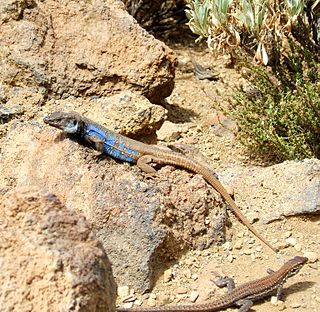
The genus Gallotia are the lacertids of the Canary Islands. This genus consists of a group that has been evolving there ever since the first islands emerged from the sea over 20 million years ago. The endemic species and subspecies of this group have a number of characteristics that make them quite special within their family (Lacertidae); their only close relatives are the sandrunner lizards (Psammodromus) of the western Mediterranean region. Gallotia are characteristic for eating significant quantities of plants, and several lineages are often presented as classic examples for insular gigantism. However, a find of an even larger Gallotia species from the early Miocene of mainland Europe casts doubt on this assumption. Instead the ancestor of all modern Gallotia species of the Canary islands was probably already very large but carnivorous.

Teide, or Mount Teide, is a volcano on Tenerife in the Canary Islands, Spain. Its summit is the highest point in Spain and the highest point above sea level in the islands of the Atlantic. If measured from the ocean floor, its height of 7,500 m (24,600 ft) makes Teide the third-highest volcano in the world, and is described by UNESCO and NASA as Earth's third-tallest volcanic structure. Teide's elevation above sea level makes Tenerife the tenth highest island in the world.

The La Gomera giant lizard is a lacertid species that can be found on the island of La Gomera, one of the Canary Islands.

The El Hierro giant lizard is the only extant, critically endangered subspecies of Simony's giant lizard. It is endemic to El Hierro, the westernmost of the Canary Islands, where it is an official symbol.
The La Palma giant lizard is a large wall lizard endemic to the island of La Palma in the Canary Islands, currently extinct or critically endangered.

Simony's giant lizard is a large species of wall lizard endemic to the island of El Hierro and nearby islet Roque Chico de Salmor in the Canary Islands.

The Roque Chico de Salmor giant lizard is the extinct nominate subspecies of Simony's giant lizard, which was endemic to the small islet Roque Chico de Salmor northwest of El Hierro, the westernmost of the Canary Islands.

The Tenerife speckled lizard is a recently discovered lacertid endemic to Tenerife in the Canary Islands. It is the smallest member of the clade containing the western islands' giant species.

Boettger's lizard is a species of wall lizard in the family Lacertidae. The species is endemic to the Canary Islands. There are two recognized subspecies.
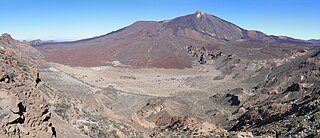
Teide National Park is a national park located in Tenerife, Canary Islands, Spain.

Boettger's wall gecko, also commonly known as the Gran Canaria gecko, is a species of lizard in the family Phyllodactylidae. The species is native to the Canary Islands and the Savage Islands. There are three recognized subspecies.

The Gran Canaria giant lizard is a species of lizard in the family Lacertidae. The species is found in the Canary Islands.

Guayota, in Guanche mythology of Tenerife, was the principal malignant deity and Achamán's adversary.
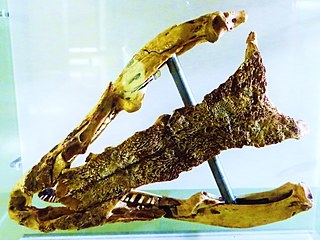
Gallotia goliath is an extinct giant lizard species from the island of Tenerife of the Canary Islands, Spain. This reptile lived before the arrival of humans and is believed to have grown to at least 0.9 metres (3.0 ft) long. It was described by the German herpetologist Robert Mertens. Fossils of this lizard have been found in volcanic caves, where they often appear with those of other animals, like the Tenerife giant rat.
Philipp Lehrs (1881–1956) was a German herpetologist who specialized in the lizard family Lacertidae. During his career, he was associated with the Zoologischen Forschungsinstitut and Forschungsmuseum Alexander Koenig in Bonn.
